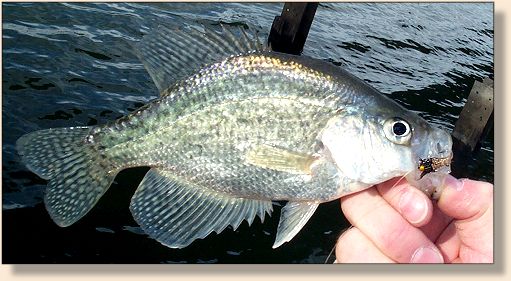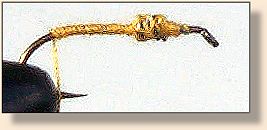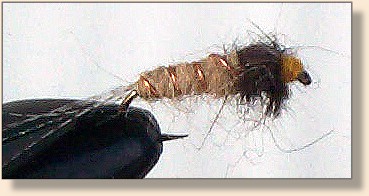I was reading through the Tying tips section when I read the
tips about sizing bead heads. As I read it I remembered the trouble
I have had with bead heads. When I first becan using them they
worked great, but were difficult for me to get tied right. I either
had too much of a whip finish behind the bead, or in front of the
bead, or sometimes the rear edge of the bead would even cut the
thread as I was finishing it.
This got me to thinking there just HAD to be an easier way. I went
down to my favorite fly-tying material shop (Wally World's Sewing
Department) and began a search. They had some beads that looked
smoother, but that was not the answer I was seeking. Then I passed
down the aisle with the sewing thread and the light went on.
They had some very nice gold and copper threads. I bought some and
began to play. I discovered I could use my regular weight (lead or not)
on the hook and then use the gold or copper thread to tie the head that
finished the fly. I could even build it up to have the bulky bulge of
a bead if I desired - but when I tried fished them, it seemed the fish
didn't care whether the head bulged or not. For me it was easier to
tie and less frustrating. I have never bought a bead since.
This also opens the door to experimentation. I can add more or less
weight than the bead would add without changing the look of the fly.
More weight for faster water, less for slower, same size fly. It
works for me.

The LadyFisher asked if I had any photos of my flies, and when I checked
my fly selection I found it seriously diminished. So over lunch I sat
in the back of my old Trooper in the parking lot of the closest reservoir
to my work and tied a size 10 Faux Bead Head Hare's Ear. I then plied it
on said body of water to see if the warmwater finned friends would appreciate it
as much as the trout in American Fork and Provo Canyons back in Utah did.
I was not disappointed. I probably cast ten times and used a slow
wrist-twist retrieve. They were released unharmed to their watery home
after posing briefly. (A little help with identification would be nice.
Still working on that with the warmwater friends.) Unfortunately I didn't
check the pictures I took until I returned to the office, and it appears I
overestimated the macro capabilities of the camera I had access to.
They are blurry...I would try some more, but once more the fly is rather
chewed up (not that I am complaining about that, it is better to have the
fish chew them than the bushes.)

I took lunch again and ran out to try and get some good picture to use
on the site. I decided this time I would tie the Faux Headhead Hare's Ear
with a lighter body this time and still the dark thorax, and it was a good
thing.


After getting the pictures of the fly, I wandered down to the water
to see how things were today, since it has been in the 60's for three days
in a row. I began using the fly I tied earlier this week, and was not
having much luck, so I decided to switch to the one I had just tied. This
proved to be a good move as I was into another Crappie on the fifth cast.
It was followed by two more and they look like they all came from the same
mold. Had to be a real slow hand twist retrieve pretty deep. As I was
taking the attached photo of that first one, a fellow angler joined
me on the bank and began fishing with minnows. I wish I could say I
outfished him, but that was not the case. He was catching Bass in the
6-12 inch range in fairly shallow water, so I began casting along the
bank and using the same slow hand twist retrieve when I hooked a Bass
myself. I got it up close and as I was reaching for the camera, I
performed a perfect Long Distance Release, so there is no proof. I was
able to catch a couple more Crappie before I had to return to work.
All in all, a perfect lunch hour! ~ Don Rolfson
Please check out the Fly Tying Section, on the Bulletin Board, here at FAOL too.
If you have any questions, tips, or techniques; send them to
publisher@flyanglersonline.com
|







